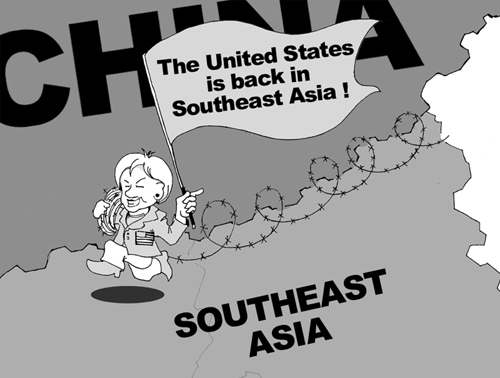How US can enhance cooperation with Southeast Asia
On July 22, 2009, the US Secretary of State Hillary Clinton signed the Instruments of Accession and Extension to the Treaty on Amity and Cooperation in South-East Asia (TAC) marking the US formal accession to the treaty. Also on July 23, Clinton and her counterparts from Cambodia, Laos, Thailand and Vietnam agreed to set up a working group to develop Mekong-Mississippi cooperation. These actions underlined Clinton's statement that "The United States is back in Southeast Asia".
 |
|
Liu Pei/China.org.cn |
Southeast Asia has long been a key area for US global strategy. In February 2009 when Hillary Clinton visited the ASEAN HQ, she announced the US intention to sign TAC in order to promote security cooperation with ASEAN. The US is a traditional ally of Thailand and the Philippines and has a close relationship with Singapore and Indonesia, but was the last major Asia-Pacific power to sign TAC.
Southeast Asia is one of the fastest developing regions in the world. ASEAN is one of the United States' largest trading partners and an important holder of the US national debt, which is a key factor in US stabilization and recovery plans.
The US "has to be involved in this region". ASEAN integration has made great strides in recent years and the US cannot ignore ASEAN's growing power on the world stage. ASEAN integration is in turn driving East Asian integration with ASEAN as its core. The development of the US-ASEAN relationship is a recognition of the rise of ASEAN's political status in international affairs.
The US is being obliged to pay more attention to multilateral cooperation. The ASEAN Regional Forum, ASEAN Summit and East Asian Summit are important forums for ensuring the stability and prosperity of East Asia and surrounding regions. Since the end of cold war, East Asian integration between ASEAN, China, Japan and ROK has been progressing rapidly. The US accession to TAC signifies that the US is moving towards resolving international issues via multilateral bodies, not by acting as regional leader.
ASEAN members also welcome enhanced US cooperation in the region, considering it as "a shift in strategy on the part of the new US administration toward ASEAN." They hope the US will "play a larger and more active role in helping to support ASEAN's efforts to realize an ASEAN Community", by engaging constructively and maintaining peace and stability in the region.
The US signing of TAC reflects its new approach to the security environment of Southeast Asia. The US had been reluctant to sign TAC because of its clause on peaceful settlement of disputes, renunciation of the use or threat of force, and noninterference in the internal affairs of other members. In the ARF, ASEAN and its external partners have maintained the regional security and stability by confidence-building measures, preventive diplomacy and conflict-resolution mechanisms. Stability is not only beneficial to ASEAN countries but also to the US, which can, as a result, invest its strategic resources in turbulent regions such as the Middle East.
Of course, we should keep in mind that TAC does not have the power to punish violators of its rules. There is general consensus that ASEAN will not interfere in the domestic affairs of its members. However, as a superpower, the US needs to be more responsible in its international activities. TAC may restrict the tendency of US policy to intervene in the domestic affairs of ASEAN members and its partners.
ASEAN practices open regionalism, and a "balancing" policy among its partners. Generally speaking, ASEAN is not a platform for its partners to compete and struggle against each other, but a stage for them to work together. The US should enhance cooperation with other members in the ARF, and act flexibly to promote the stability of the region. From this standpoint, it is not appropriate for Clinton to send tough messages to Iran, DPRK and Myanmar.
There are many limitations to US participation of Southeast Asia affairs. The US is still hesitating over participation in the East Asia Summit and is not willing to cooperate with all countries in the lower Mekong basin. If the US seeks to "actively" engage with Southeast Asia by creating new regimes, it will present a great challenge to ASEAN, which relies on mature multilateral cooperation regimes.
Therefore, the US must pay more attention to the reality and significance of ASEAN integration The US should respect the status quo of the Southeast Asia regional security environment, and prevent regional turbulence. Other countries should also make sure they do not disturb the regional order.
 0 Comments
0 Comments







Comments